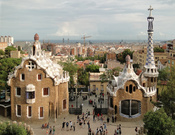SPANISH ARCHITECTURE
Introduction
Through out the different cities I have visited, what I have enjoyed the most is the architecture. My most important stop in each city is a place where I can see the horizon and of coarse the buildings before it. For example, if you stand in front of the Sacre-Coer in Paris you can see the white buildings almost all of them about 6 stories high, the Tower Eiffel and the Arc de Triumph. In Florence if you stand in the edge of Plaza Michealangelo you can see the orange top buildings, the beautiful Ponte Veccio, Plaza de la Signoria and the huge Il Duomo. In Barcelona, at the Park Güell, you have an amazing view of the ocean and the very similar street blocks, perfectly symmetrical with the exception of the Gothic Quarter and everything above the Diagonal, without forgetting about the Sagrada Familia. For me, architecture is what tells you about the history of the city, without telling it to you in words.
Each city, even each quarter tells you about its history.
Jonathan Glancey describes it this way, "At it best, architecture, an art that goes beyond the simple construction of buildings, is able to rise the spirit and [amaze] us with its beauty and grandiosity; and at its worse, in turn, [it makes us small and unworthy], although this should never happen."
In Spain, I have lived in Barcelona and gone to Bilbao, Pamplona in the Basque Region, Sevilla and Granada in Andalusia, Madrid, Toledo, Aranjuez, El Escorial, and Salamanca in the center of the country. I personally prefer Spain's contemporary architecture, and I am amazed with La Alhambra, but to understand these two styles of architecture we have to go back through out time, and see how architecture has changed in Spain.


